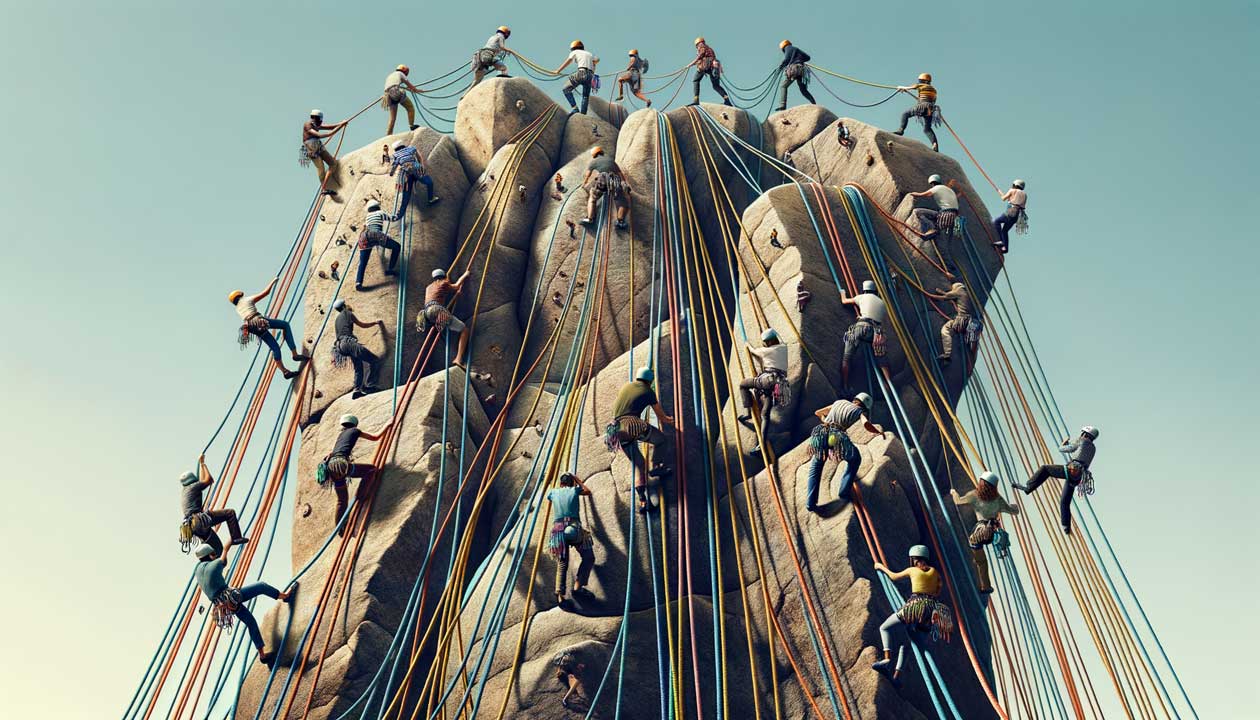In a world where versatility and durability are paramount, braided cordage and rope cordage have emerged as the unsung heroes across a myriad of industries. From the rugged outdoor adventures to the high-stakes safety and rescue operations, these ingenious tools have proven their mettle time and time again. Whether you're securing camping gear, rigging sailing vessels, or relying on a lifeline during perilous rescues, the strength and reliability of braided cordage and rope cordage are unmatched.
At the core of their exceptional performance lies a unique construction method that intertwines multiple strands of high-quality fibers into a seamless, interwoven design. This intricate braiding process not only enhances overall strength but also ensures an even distribution of stress, minimizing weak points and maximizing load-bearing capabilities. The result is a cordage solution that can withstand the toughest challenges, whether it's battling the elements in the great outdoors or enduring the rigors of industrial applications.
What truly sets braided cordage and rope cordage apart, however, is their sheer versatility. From the depths of the ocean to the soaring heights of wind turbines, from construction sites to aerospace operations, these remarkable tools have carved out a niche in countless specialized applications. With their unparalleled strength, flexibility, and resistance to abrasion, kinking, and environmental degradation, braided cordage and rope cordage have become the go-to choice for professionals who demand nothing less than unwavering performance.
Join us on this captivating journey as we explore the top uses for braided cordage and rope cordage across diverse markets and scenarios. Discover how these innovative cordage solutions are revolutionizing industries, empowering outdoor enthusiasts, and safeguarding lives in the most demanding rescue operations. Whether you're a seasoned professional or a curious newcomer, this blog post promises to shed light on the incredible versatility and importance of braided cordage and rope cordage, opening your eyes to the endless possibilities they offer.
Braided Cordage: The Ultimate Outdoor Companion
When it comes to exploring the great outdoors, having the right gear can make all the difference. One essential item that should be in every adventurer's pack is braided cordage. This versatile and durable rope is a true game-changer for camping, hiking, boating, and off-road excursions. Let's dive into why braided cordage is the ultimate companion for your next outdoor adventure.

Versatile and Durable: Exploring the Benefits of Braided Cordage
What sets braided cordage apart from traditional ropes is its superior strength and abrasion resistance. The specialized weaving technique used to create braided ropes intertwines the fibers in a way that distributes stress evenly, resulting in a rope that can handle heavy loads and withstand tough conditions. Whether you're setting up a tent, securing gear, or creating an emergency shelter, you can trust braided cordage to get the job done.
Another advantage of braided cordage is its flexibility and resistance to kinking and stretching. The woven structure allows the rope to bend and flex without compromising its integrity, making it easier to work with in a variety of situations. This flexibility also translates to improved knot-tying capabilities, ensuring your knots stay secure and don't slip under pressure.
Braided cordage is available in a range of materials, each with its own unique properties. Nylon, polyester, and polypropylene are common choices, offering a balance of strength, durability, and weight. When selecting your braided rope, consider the specific requirements of your outdoor activities. For example, nylon is known for its elasticity and shock absorption, making it ideal for applications like climbing and boating. Polyester, on the other hand, is resistant to UV rays and moisture, perfect for long-term outdoor use.
Outdoor Adventures Made Easy with Braided Ropes
One of the greatest benefits of braided cordage is its compact size and lightweight nature. When every ounce counts in your backpack, having a reliable rope that doesn't add unnecessary weight is crucial. Braided ropes can be easily coiled and stored, taking up minimal space while still providing ample length for your needs. This portability makes braided cordage a must-have for hikers, campers, and outdoor enthusiasts who value efficiency and convenience.
In addition to its compact size, braided cordage is incredibly easy to handle, even in wet or challenging conditions. The rope's flexibility and grippy texture allow for a secure hold, reducing the risk of slippage or accidents. Whether you're tying down a kayak on a windy day or setting up a bear bag in the rain, braided cordage provides the control and confidence you need to tackle any task.
To get the most out of your braided rope, it's essential to familiarize yourself with some basic knot-tying techniques. Learning how to tie a bowline, clove hitch, or trucker's hitch can greatly expand the functionality of your cordage. These knots are not only useful for securing items but can also be used to create makeshift tools, repair gear, or even fashion a makeshift stretcher in an emergency situation. With a little practice and creativity, the possibilities are endless.
So, the next time you head out on an outdoor adventure, make sure you have a reliable braided rope by your side. From setting up camp to navigating unexpected challenges, this versatile tool will prove to be an indispensable companion. With its superior strength, durability, and ease of use, braided cordage is the ultimate solution for all your outdoor cordage needs. Trust in the power of braided ropes and embark on your next adventure with confidence.
Industrial Applications of Cordage Rope
When it comes to industrial settings, cordage ropes are the unsung heroes that keep operations running smoothly and safely. These versatile and durable ropes, made by twisting or braiding fibers together, have become indispensable in a wide range of applications. From construction sites to wind power stations, cordage ropes are proving their worth as reliable and cost-effective alternatives to traditional materials like steel wire ropes.

One of the key advantages of cordage ropes is their strength-to-weight ratio. High-performance fiber ropes, such as those made from ultra-high-molecular-weight polyethylene (UHMWPE), can offer the same or even better load-bearing capabilities as steel wire ropes while being significantly lighter. This makes them easier to handle, transport, and install, reducing the risk of worker fatigue and injuries. Additionally, fiber ropes are more flexible and resistant to kinking, making them suitable for applications where the rope needs to bend or wrap around objects.
Ropes for Sun Protection Systems
In the realm of sun protection, cordage ropes play a crucial role in the installation and operation of awnings, canopies, and shades. Fiber ropes, particularly those resistant to UV radiation and weathering, are used to secure these structures and provide reliable support against wind and other environmental factors. The flexibility and durability of these ropes ensure that sun protection systems remain stable and functional, even in challenging outdoor conditions.
Ascenders for Wind Power Stations
As the world shifts towards renewable energy, wind power stations have become increasingly common. Maintaining and repairing these towering structures requires specialized equipment, including cordage ropes used as ascenders. These ropes, chosen for their strength and lightweight properties, allow technicians to safely access the wind turbines for routine inspections and maintenance tasks. To ensure the highest level of safety, ropes used in wind power stations often undergo rigorous testing and certification processes.
Fiber Ropes as Sealing Elements
In various industrial settings, fiber ropes have found a niche as effective sealing elements. Their flexibility and resistance to chemicals, high temperatures, and abrasion make them suitable for use in applications where traditional sealing materials may fail. From sealing pipe connections to insulating electrical components, fiber ropes offer a versatile and reliable solution. Industries such as oil and gas, chemical processing, and manufacturing have increasingly adopted fiber ropes as sealing elements to improve efficiency and reduce maintenance costs.
Ropes for Electric Tools and Automotive Industry
Cordage ropes have also found their way into the realm of electric tools and the automotive industry. In power tools and rope-operated tools, cordage ropes serve as the driving force, transmitting power and enabling precise control. In the automotive sector, particularly in convertible top drives, cordage ropes are used to operate the folding and unfolding mechanisms of car roofs. The strength, durability, and flexibility of these ropes ensure smooth and reliable operation, even under the stresses of high-speed driving and frequent use.
Synthetic Ropes for Deep Hole Drilling
Deep hole drilling, a process used in the oil and gas industry and geological exploration, relies on synthetic cordage ropes to lower and raise drilling equipment in boreholes. Compared to steel wire ropes, synthetic ropes offer several advantages, including corrosion resistance, reduced weight, and improved handling. These properties make synthetic ropes an attractive choice for deep hole drilling operations, where reliability and efficiency are paramount. For more on the benefits of synthetic versus steel rope, check out Synthetic Rope vs Steel Wire: Benefits and Best Uses.
As industries continue to evolve and face new challenges, the demand for innovative and high-performance cordage ropes is expected to grow. Manufacturers are constantly developing new materials and construction techniques to enhance the strength, durability, and functionality of these ropes. By staying at the forefront of these advancements, businesses can ensure that they have the right cordage solutions for their specific industrial applications, ultimately improving safety, productivity, and profitability.
The versatility and reliability of cordage ropes have made them an essential component in various industrial applications. As technology advances, we can expect to see even more innovative uses for these remarkable tools.
Rope Cordage in Safety and Rescue Operations
When lives are on the line, every piece of equipment matters. In the world of safety and rescue operations, rope cordage plays a critical role in ensuring the success of missions and the well-being of those involved. From firefighting to military operations, and from recreational climbing to caving, the right rope can make all the difference between a successful rescue and a tragic outcome.

When selecting ropes for safety and rescue applications, several critical factors come into play. First and foremost, the rope must have the necessary strength and durability to withstand the rigors of the operation. Whether it's supporting the weight of a rescuer and victim during a high-angle rescue or serving as a lifeline in a confined space, the rope must be able to handle the load without fail. Discover our range of high-quality fiber ropes designed to meet these critical demands.
Another key consideration is abrasion resistance. Rescue ropes often come into contact with rough surfaces, sharp edges, and harsh environments. A rope that can resist abrasion and maintain its integrity under these conditions is essential for the safety of all involved. This is where the choice of materials and construction techniques comes into play.
To ensure the highest level of safety and performance, ropes used in rescue operations must meet stringent standards set by organizations like the National Fire Protection Association (NFPA). The NFPA 1983 standard, in particular, sets the bar for life safety ropes, outlining the minimum requirements for strength, elongation, and other critical properties. When lives are at stake, there can be no compromise on the quality and compliance of the ropes used.
Types of Ropes Used in Rescue Operations
In the realm of safety and rescue, not all ropes are created equal. Different types of ropes are designed to meet the specific needs of various operations. One of the most common and highly regarded types is the kernmantle rope.
Kernmantle ropes feature a core (kern) of long, continuous fibers that provide the rope's strength and a protective sheath (mantle) that encases the core. This construction offers several advantages, including excellent strength-to-weight ratio, resistance to abrasion, and improved handling characteristics. Kernmantle ropes are widely used in applications such as rappelling, high-angle rescue, and mountain rescue.
Other common materials used in rescue ropes include nylon and polyester. Nylon ropes are known for their elasticity and energy absorption capabilities, making them suitable for dynamic applications like rock climbing. Polyester ropes, on the other hand, offer lower stretch and better resistance to moisture and UV degradation, making them a popular choice for static applications and water rescue.
Importance of Life Safety Ropes
When it comes to situations where human lives are directly dependent on the rope, the term "life safety rope" takes on a whole new level of significance. These ropes are specifically designed and tested to meet the most stringent safety standards, ensuring that they can withstand the immense responsibility placed upon them.
Life safety ropes undergo rigorous testing and certification processes to ensure they meet the required strength, elongation, and performance criteria. This testing often involves subjecting the ropes to extreme loads, simulating worst-case scenarios to guarantee their reliability in real-world situations.
It cannot be overstated how crucial it is to use only certified life safety ropes in rescue operations. Using non-compliant or substandard ropes can have catastrophic consequences, putting the lives of rescuers and victims at risk. The consequences of a rope failure in a life-or-death situation are unthinkable, which is why there can be no compromise when it comes to the quality and certification of life safety ropes.
In conclusion, rope cordage plays a vital role in the success and safety of rescue operations across various domains. From the selection of the right type of rope to the adherence to stringent safety standards, every aspect of rope usage in rescue must be carefully considered and executed. By understanding the importance of factors like strength, durability, abrasion resistance, and compliance with standards like NFPA 1983, rescue teams can ensure that they have the right tools to perform their duties effectively and safely. Remember, in the world of safety and rescue, the quality and reliability of the rope can be the difference between life and death.
Specialized Uses of Braided Cordage and Rope
Braided cordage and rope are the unsung heroes of countless industries, offering unparalleled strength, durability, and versatility. These remarkable tools have become indispensable in a wide array of specialized applications, from the depths of the ocean to the vast expanse of the sky. Let's dive into the world of braided cordage and explore how these incredible ropes are making a difference in various sectors.

What sets braided cordage apart from traditional twisted ropes is its unique construction. By interweaving multiple strands of fibers in a crisscross pattern, braided ropes achieve superior strength, flexibility, and resistance to abrasion. This intricate braiding process allows the load to be evenly distributed throughout the rope, minimizing weak points and ensuring consistent performance under demanding conditions.
The advantages of braided cordage extend far beyond its impressive strength. Unlike twisted ropes, which can kink and become tangled, braided ropes maintain their shape and flexibility even when bent or curved. This property makes them ideal for applications that require intricate rigging or securing irregular loads. Additionally, the smooth surface of braided ropes facilitates easier handling and reduces friction, making them a top choice for applications where efficiency and precision are paramount.
Applications of Braided Ropes in Various Industries
The construction industry is one of the major beneficiaries of braided cordage's exceptional properties. From lifting heavy materials to securing scaffolding, braided ropes play a crucial role in ensuring safety and productivity on construction sites. Their ability to withstand high loads and resist abrasion from rough surfaces makes them an indispensable tool for workers operating in challenging environments.
In the marine world, braided ropes have become the go-to choice for a multitude of applications. Whether it's mooring lines for boats, towing ropes for water sports, or rigging on sailboats, braided cordage offers the perfect combination of strength, durability, and flexibility. The resistance to moisture and UV degradation exhibited by certain types of braided ropes further enhances their suitability for use in harsh marine conditions.
Outdoor enthusiasts have also embraced the benefits of braided cordage. From rock climbing to rappelling, braided ropes serve as reliable lifelines, ensuring the safety of adventurers as they push their limits. The dynamic properties of braided climbing ropes allow them to stretch and absorb the energy of falls, reducing the risk of injury. In the realm of camping and hiking, braided ropes prove invaluable for setting up tents, securing gear, and even creating makeshift bridges to cross streams or ravines. Learn more about the versatility of various ropes for outdoor use in our article on polypropylene rope.
The aerospace and aviation industries rely heavily on braided cordage for various critical applications. From tie-down straps for securing cargo to fall protection systems for maintenance crews, braided ropes offer the necessary strength and reliability to ensure the safety of personnel and equipment. In the demanding environment of aircraft manufacturing and maintenance, where precision and adherence to stringent regulations are non-negotiable, braided cordage has earned its place as a trusted ally.
Advantages of Braided Cordage Over Traditional Ropes
When compared to traditional twisted ropes, braided cordage offers several distinct advantages. One of the most significant benefits is its resistance to kinking. Unlike twisted ropes, which can develop kinks and loops when under tension, braided ropes maintain their structural integrity, allowing for smoother operation and reduced downtime.
Another advantage of braided cordage lies in Exploring the uses of braided cordage and rope cordage reveals their indispensable roles across various industries like camping, agriculture, and safety operations.
From setting up tents in outdoor adventures to providing lifelines in rescue missions, these ropes offer unmatched durability and versatility. Selecting the right cordage rope ensures you get superior performance and reliability for specialised tasks, whether it’s for boating, heavy lifting, or tactical military gear. Understanding the unique attributes of each type of cordage can help you make informed decisions to suit your specific needs, ensuring safety and efficiency in every application.
Discover Custom Rope Solutions for Your Needs
Fill out the form above to inquire about customised braided cordage and rope cordage. Our experts at iRopes are ready to help you find the perfect solution tailored to your industry and specific requirements.